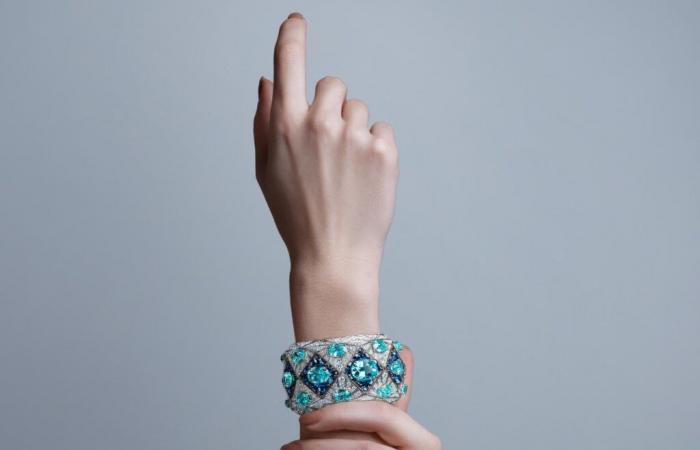The cuff reveals, on a bed of triangles paved with diamonds and lozenges of midnight blue sapphires, voluminous gems of vibrant turquoise blue: so-called “paraiba” tourmalines. « 52,12 carats » in total, details the commercial description with attention to accuracy, while surrounding the price with a modest acronym: “POA” for price on application (“price on request”). “One of the first qualities I look for in a stone is its color and, in this regard, paraiba tourmalines never disappoint. Their hue between turquoise and blue-green is unique, and their liveliness unrivaled. What sets them apart from all other stones in the world »praises the designer of this bracelet, Jeremy Morris, CEO and artistic director of jeweler David Morris.
The Londoner was one of these precursors, more than twenty years ago, to adopt paraiba tourmaline. In recent seasons, it has gained ground at Cartier, Chaumet and Louis Vuitton in Paris, at Bulgari in Rome and Pomellato in Milan. Here it is now one of the rare stones, along with spinel, not appearing among the four precious stones according to traditional typology (diamond, emerald, ruby, sapphire), but capable of approaching the level of rarity and price. The last to succumb is the Gucci house, which, despite turbulence and a radical change in artistic direction, has been trying to define a jewelry identity since 2019. For the past year, it has made paraiba tourmaline one of its favorite materials. , stuck in the mouth of a lion in white gold on a signet ring, cut into a heart on a baroque bracelet or accompanying yellow sapphires on earrings.
“Its color reminds me of the pleasure of swimming in the sea and surfing, exults Ana Khouri, a Brazilian independent designer based in New York, who can work it in all shades, from vibrant turquoise to paler blue-green. The earth is capable of producing incredible gems, but there is something unique about the paraiba, an inspiring depth and brilliance. » The Frenchwoman Marie-Hélène de Taillac prefers it an intense blue-green “Caribbean Sea style” rather than pool blue. “I discovered it in 1997 in Tucson [en Arizona, une des foires de pierres maîtresses du secteur] : with this almost fluorescent luminosity, it looked like nothing else”remembers the one who lives between Paris and India, where her tangy jewelry is made.
Industry “fervor”
When some, like Victoire de Castellane at Dior, dare to associate it with pink sapphires, spessartite garnets (bright orange) or red spinels, Marie-Hélène de Taillac prefers “stay in blue and green tones, combining it for example with emeralds, aquamarines or pastel tanzanites. But the truth is that, in most cases, I prefer it alone, as a solitaire or as a pendant, coated in a bezel setting”she summarizes.
“It is a stone of such a particular color that it needs, dare I say, room to breathe”agrees Ana Khouri, whose latest creation takes the form of a tubular gold torque necklace on which a 24-carat oval paraiba tourmaline seems to float. “For my part, I am keen to leave it with its oceanic aspect”suggests Swiss jeweler Doris Hangartner, who, in her jewelry, contrasts the black and white of carbon fiber, diamonds and pearls.
With kunzite in 1902, morganite in 1911 or tanzanite in 1967, paraiba tourmaline is among the gems discovered in the 20th century.e century. From 1981, in Brazil, in the state of Paraiba, an entrepreneur named Heitor Dimas Barbosa (1933-2023) began excavating his region through the dozen mines he owned. He squandered his fortune there and weakened his health. Then, faced with pressure from those close to him, he gave up his prospecting one by one.
Until one day in 1987 when, in the district of Sao José da Batalha, an almost fluorescent blue tourmaline was unearthed, “just when he was about to give up everything”traces Leandro Scheibler, the commercial director of the original mine, renamed “Heitorita”. “When he sent the specimens to the laboratory, the gemological experts were skeptical and thought that such color and brilliance could only be synthetic. But as soon as they confirmed that it was indeed a new type of tourmaline, the demand was there. For its introduction at the Tucson fair in February 1989, the carat exchanged for 100 dollars at the start and for 10,000 at the close, four days later. The industry has never seen such fervor. »
“Almost unreal” material
The fact remains that it is rather the independent creators who are infatuated with it. Place Vendôme, we first look from a distance at this new lagoon blue gem which seems, according to the usual expression used by its promoters, “light up from within”like neon. Twenty years ago, certain merchants could leave prestigious Parisian houses after being turned away: “This is wrong, this will never work!” » At Dior, where the colorist Victoire de Castellane took on them from 2007 in center stones, we remember the feeling of having faced, the first times, a “almost unreal material”.
Newsletter
“The Taste of the World”
Travel, fashion, gastronomy, design: the best of the art of living, in your email box
Register
Little by little, however, paraiba tourmaline gains prestige and appears in collections. On the one hand, the 2000s slowly established the use of previously snubbed fine stones, including tourmalines, but also garnets and spinels. On the other hand, mines were discovered at the same time, in Mozambique and Nigeria, producing tourmalines of an equivalent nature, although less expensive, which increased the quantity of gems available. “Tourmalines are found in pegmatites, pockets of gas and liquid inside the rock that cool and crystallize. Tourmaline, from the silicate family, can have a color that varies depending on the chemical elements that compose it and can be sodium, potassium, aluminous or ferrous. But what characterizes and forms the singular blue of the paraiba are the copper atoms: this is how we can distinguish it.explains gemologist Olivier Segura, director of the Asia-Pacific branch of the School of Jewelry Arts (funded with the support of Van Cleef & Arpels).
Read also | High jewelry: stones in all tones
Read later
If the big names of Place Vendôme swear not to use stones “processed”that is to say altered by man – an assertion which leaves some experts skeptical – it is not uncommon for paraiba tourmalines in circulation to be heated up to around 500 degrees. An intervention intended to maximize the radiance of their bluish tint.
Even though paraiba theoretically designates the origin of Brazilians, whose mines have dried up and whose carat can nowadays be exchanged between 100,000 and 250,000 dollars, the marketing departments of most jewelers, without being embarrassed, also designate as paraiba gems from Mozambique or Nigeria (with the exception of Chaumet, which prefers to stipulate “paraiba type”). These, a little greener or slightly purplish due to the stronger presence of manganese, now sell for between $40,000 and $50,000 per carat.
Fare inflation
At key fairs, in Tucson in February or Hong Kong in September, we see that prices increase by around 20% each year. “It’s more and more difficult to find them at our quality level. Most are either excessively pastel or riddled with inclusions [des éclats et impuretés visibles à l’œil nu]. And, once we manage to find a clean and intense material, prices take off very quickly and very high”attests the person responsible for purchasing colored stones at Chaumet, whose identity the jeweler demands remains confidential.
Read also | Diamonds, tourmalines, aquamarines: the boom in second-hand stones
Read later
Jeremy Morris, for his part, often favors buying old jewelry at auction to obtain supplies. Dismantling the paraiba tourmalines in order to reuse them, he assures that, despite the inflation of prices, his followers continue to ask him for them: “As their rarity is understood, the demand for this stone increases among our customers. » The same comparison report circulates in the industry: we would find a paraiba tourmaline every 10,000 diamonds. To the point that it also becomes a collected stone in its own right.
Thirty-seven years after its discovery, “it is one of those investments that only increases in value”praises the jewelry designer Doris Hangartner, who has also become a merchant since 2012. And to cheerfully exhibit, from Zurich, in addition to the pendant of her necklace, a paraiba cut into a heart which adorns her chest, a second unmounted stone of 117 carats , the size of a small pebble.






